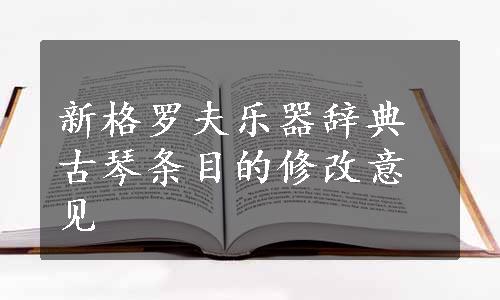
自《新格罗夫乐器辞典》出版30年来,古琴音乐在中国的发展出现了很大的变化,从一种几乎被边缘化的传统乐器和乐种发展成为一种吸引了大批民众和媒体关注、具有显赫地位的国粹和国宝级的艺术形式。对这一现象“古琴”条目给予了如下叙述:
“2003年,联合国教科文组织宣布古琴为‘人类口头与非物质遗产代表作’之一。自那时起,古琴重新得到了显著而广泛的喜爱。越来越多的古琴社团成立了;各种年龄段的表演比赛在全国展开;古琴制造中心如扬州和北京已经大批量生产古琴,以满足人们对新乐器的需求。”[11]
一个学科的发展往往凝聚着一代又一代人的智慧和艰辛,通过后浪推前浪的不断前进,人类在特定领域里对自然的认识也不断逼近真实的客观世界。专科辞典所起到的作用往往是充当人类某类专业知识的蓄水池,它不断帮助新的学者以及更广泛的民众从中汲取知识,进行新的学术探索和研究突破。新版《格罗夫乐器辞典》作为世界音乐学术界最权威、最严肃的乐器专科辞典对中国古琴的介绍必须客观、公正和慎重。但由于辞典编辑政策以及文章篇幅等方面的诸多限制,此次修订绝非完美。期望同行们能够对新版《格罗夫乐器辞典》中的“古琴”条目提出更好的修改意见,使这个条目在下一版更新时能够更加成熟和完善,更加全面客观地反映古琴乐器和古琴音乐的历史和现实,以及中外学术界在古琴研究方面最新的学术成果和共识。
本文即将发表于《星海音乐学院学报》2018年第1期。
【注释】
[1]戴鹏海.记东方音乐学会“双庆”座谈会.人民音乐,1990(2):29.
[2]half⁃tube是萨克斯分类体系中的一个子类概念名称。古琴在萨克斯分类体系中属于这一个子类。
[3]郑祖襄.“徽”字与徽位——兼考古琴徽位产生的历史年代.中央音乐学院学报,1986(4):27.
[4]饶宗颐.说 兼论琴徽.中国音乐学,1989(3):31.(www.daowen.com)
[5]许健.西汉有琴徽吗?——与饶宗颐教授商榷.中国音乐学,1988(1):117.
[6]冯洁轩.说徽——兼议郑、饶二文.中国音乐学,1988(4):83.
[7]吴钊.释“徽”——与冯洁轩君商榷.中国音乐学,1989(3):34.
[8]“Based on Chinese historical resources,some musicologists believe the hui appeared during the Western Han Dynasty(206 BCE—9 CE),but the seven⁃stringed qin excavated in the Mawangdui site of the Han Dynasty in Hunan Province does not yet have them.Musicologists commonly agreed that the hui appeared at some time during the 3rd century CE.”The Grove Dictionary of Musical Instruments:4.Oxford:Oxford University Press,2014:195.
[9]喻辉.从扎利诺音阶的实践看古琴音乐的纯律与“复合律制”问题.中国音乐学,2014(2):104-109.
[10]“Historical sources indicate that qin music uses scales generated by traditional san fen sun yi(subtraction and addition of thirds of string ratios)method,a theory recorded in Guanzi(‘Master Guan’)of the Mid⁃Zhou Period(771 BCE—476 BCE),equivalent to the Pythagorean tuning in which the frequency relationships of all intervals are based on the ratio 3:2,or cycles of fifths.Based on the analysis of extant qin tablature,modern Chinese musicologists have discovered that,generally,just intonation has been used in qin music ever since the 13 hui first appeared,although Chinese historical sources do not have detailed accounts of the existence of just intonation.”The Grove Dictionary of Musical Instruments:4.Oxford:Oxford University Press,2014:193.
[11]“In 2003,UNESCO proclaimed qin music as one of the Masterpieces of the Oral and Intangible Heritage of Humanity.Since then qin music has regained remarkable popularity.More qin clubs have been formed;performance competitions for various ages have been organized nationwide;and qin construction centres such as Yangzhou and Beijing have achieved large⁃scale output to meet demand for new instruments.”The Grove Dictionary of Musical Instruments:4.Oxford:Oxford University Press,2014:196.
免责声明:以上内容源自网络,版权归原作者所有,如有侵犯您的原创版权请告知,我们将尽快删除相关内容。






